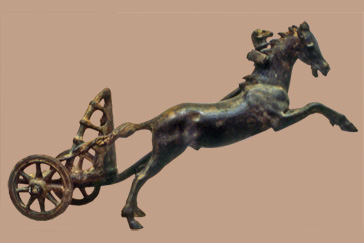

The use of these has ceased in my time among the Greeks, though traditional with them, but is preserved by the Romans in all their ancient religious ceremonies. The dancers were dressed in scarlet tunics belted with bronze ties, wore swords hung by their sides, and carried spears shorter than average length the men also had bronze helmets adorned with conspicuous crests and plumes. These were accompanied by flute-players, who used ancient flutes that were small and short, as is done even to this day, and by lyre-players, who plucked ivory lyres of seven strings and the instruments called barbita.

The contestants were followed by numerous bands of dancers arranged in three divisions, the first consisting of men, the second of youths, and the third of boys. This custom continued even in my days at Rome, as it was originally practised by the Greeks but it is now abolished in Greece, the Spartans having put an end to it …Thus it is plain that the Romans, who retain this ancient Greek custom to this day, did not learn it from us afterwards nor even change it over time, as we have done. After them came the contestants in both the light and the heavy games, their whole bodies naked except their loins. These were followed by charioteers, some of whom drove four horses abreast, some two, and others rode unyoked horses. Those who led the procession were, first, the Romans’ sons who were nearing manhood and were of an age to take part in this ceremony, who rode on horseback if their fathers were entitled by their fortunes to be equestrians, while the others, who were destined to serve in the infantry, went on foot, the former in squadrons and troops, and the latter in divisions and companies, as if they were going to school this was done in order that strangers might see the number and beauty of the youths of the Republic who were approaching manhood. ( This site maps the route of the Pompa and gives more details.) The author of the following passage was a Greek who believed that the Romans were descended from Greeks, and much of his discussion attempts to prove the Romans have many elements in common with the Greeks.īefore beginning the games the principal magistrates conducted a procession in honour of the gods from the Capitoline Hill through the Forum to the Circus Maximus. This made its way through the city into the Circus Maximus in a great show. First, it started with a procession called the pompa circensis in which the statues of the gods, statues of deified emperors, amd charioteers, horses and others took part. The presiding magistrate at the pompa circensis rode in a two-horse chariot behind him are the young nobles who led the parade on horseback.īefore looking at the factions and the charioteers, it is important to know what a day at the chariot races looked like. what it was like to watch as a spectator as the day unfolded.the parade, called the pompa circensis, that preceded the races.what the structure of a day of chariot racing looked like.


 0 kommentar(er)
0 kommentar(er)
